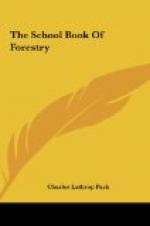When the forest rangers find evidences of serious infection, they cut down the diseased trees. They strip the bark from the trunk and branches and burn it in the fall or winter when the beetles are working in the bark and can be destroyed most easily. If the infection of trees extends over a large tract, and there is a nearby market for the lumber the timber is sold as soon as possible. Trap trees are also used in controlling certain species of injurious forest insects. Certain trees are girdled with an ax so that they will become weakened or die, and thus provide easy means of entrance for the insects. The beetles swarm to such trees in great numbers. When the tree is full of insects, it is cut down and burned. In this way, infections which are not too severe can often be remedied.
The bark-boring beetles are the most destructive insects that attack our forests. They have wasted enormous tracts of pine timber throughout the southern states. The eastern spruce beetle has destroyed countless feet of spruce. The Engelmann spruce beetle has devastated many forests of the Rocky Mountains. The Black Hills beetle has killed billions of feet of marketable timber in the Black Hills of South Dakota. The hickory bark beetle, the Douglas fir beetle and the larch worm have been very destructive.
Forest fungi cause most of the forest tree diseases. A tree disease is any condition that prevents the tree from growing and developing in a normal, healthy manner. Acid fumes from smelters, frost, sunscald, dry or extremely wet weather, all limit the growth of trees. Leaf diseases lessen the food supplies of the trees. Bark diseases prevent the movement of the food supplies. Sapwood ailments cut off the water supply that rises from the roots. Seed and flower diseases prevent the trees from producing more of their kind.
Most of the tree parasites can gain entrance to the trees only through knots and wounds. Infection usually occurs through wounds in the tree trunk or branches caused by lightning, fire, or by men or animals. The cone-bearing trees give off pitch to cover such wounds. In this way they protect the injuries against disease infection. The hardwood trees are unable to protect their wounds as effectively as the evergreens. Where the wound is large, the exposed sapwood dies, dries out, and cracks. The fungi enter these cracks and work their way to the heartwood. Many of the fungi cannot live unless they reach the heartwood of the tree. Fires wound the base and trunks of forest trees severely so that they are exposed to serious destruction by heartrot.




